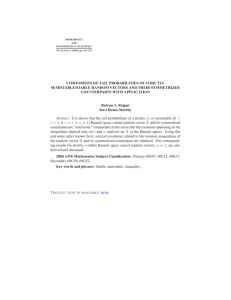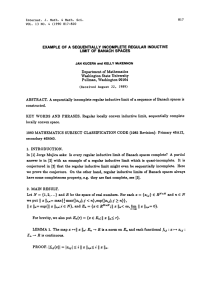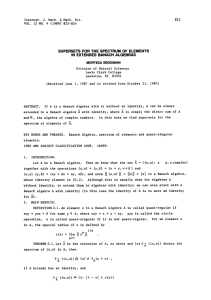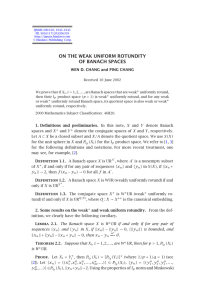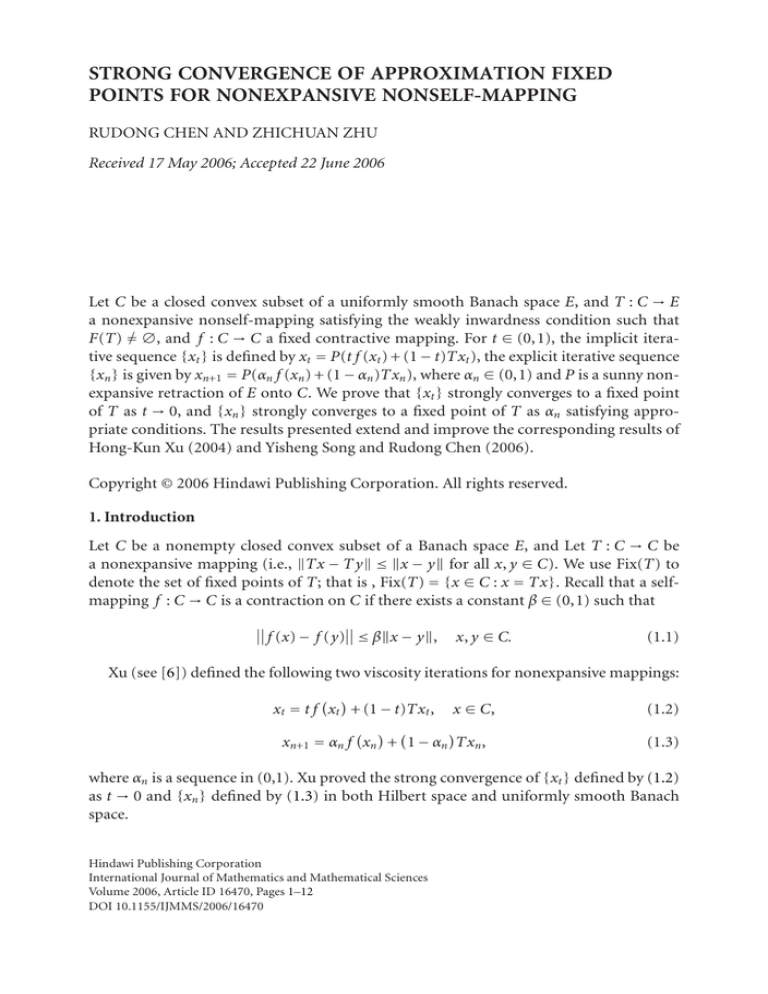
STRONG CONVERGENCE OF APPROXIMATION FIXED
POINTS FOR NONEXPANSIVE NONSELF-MAPPING
RUDONG CHEN AND ZHICHUAN ZHU
Received 17 May 2006; Accepted 22 June 2006
Let C be a closed convex subset of a uniformly smooth Banach space E, and T : C → E
a nonexpansive nonself-mapping satisfying the weakly inwardness condition such that
F(T) = ∅, and f : C → C a fixed contractive mapping. For t ∈ (0,1), the implicit iterative sequence {xt } is defined by xt = P(t f (xt ) + (1 − t)Txt ), the explicit iterative sequence
{xn } is given by xn+1 = P(αn f (xn ) + (1 − αn )Txn ), where αn ∈ (0,1) and P is a sunny nonexpansive retraction of E onto C. We prove that {xt } strongly converges to a fixed point
of T as t → 0, and {xn } strongly converges to a fixed point of T as αn satisfying appropriate conditions. The results presented extend and improve the corresponding results of
Hong-Kun Xu (2004) and Yisheng Song and Rudong Chen (2006).
Copyright © 2006 Hindawi Publishing Corporation. All rights reserved.
1. Introduction
Let C be a nonempty closed convex subset of a Banach space E, and Let T : C → C be
a nonexpansive mapping (i.e., Tx − T y ≤ x − y for all x, y ∈ C). We use Fix(T) to
denote the set of fixed points of T; that is , Fix(T) = {x ∈ C : x = Tx}. Recall that a selfmapping f : C → C is a contraction on C if there exists a constant β ∈ (0,1) such that
f (x) − f (y) ≤ βx − y ,
x, y ∈ C.
(1.1)
Xu (see [6]) defined the following two viscosity iterations for nonexpansive mappings:
xt = t f xt + (1 − t)Txt ,
x ∈ C,
xn+1 = αn f xn + 1 − αn Txn ,
(1.2)
(1.3)
where αn is a sequence in (0,1). Xu proved the strong convergence of {xt } defined by (1.2)
as t → 0 and {xn } defined by (1.3) in both Hilbert space and uniformly smooth Banach
space.
Hindawi Publishing Corporation
International Journal of Mathematics and Mathematical Sciences
Volume 2006, Article ID 16470, Pages 1–12
DOI 10.1155/IJMMS/2006/16470
2
Strong convergence of approximation fixed points
Recently, Song and Chen [2] proved if C is a closed subset of a real reflexive Banach
space E which admits a weakly sequentially continuous duality mapping from E to E∗ ,
and if T : C → E is a nonexpansive nonself-mapping satisfying the weakly inward condition, F(T) = φ, f : C → C is a fixed contractive mapping, and P is a sunny nonexpansive
retraction of E onto C, then the sequences {xt } and {xn } defined by
xt = P t f xt + (1 − t)Txt ,
xn+1 = P αn f xn + 1 − αn Txn
(1.4)
(1.5)
strongly converge to a fixed point of T.
In this paper, we establish the strong convergence of both {xt } defined by (1.4) and
{xn } defined by (1.5) for a nonexpansive nonself-mapping T in a uniformly smooth Banach space. Our results extend and improve the results in [2, 6].
2. Preliminaries
Let E be a real Banach space and let J denote the normalized duality mapping from E into
∗
2E given by
J(x) = f ∈ E∗ : x, f = x f , x = f ∀x ∈ E,
(2.1)
where E∗ denotes the dual space of E and ·, ·
denotes the generalized duality pairing.
In the sequence, we will denote the single-valued duality mapping by j, and xn → x will
denote strong convergence of the sequence {xn } to x. In Banach space E, the following
result is well known [1, 3] for all x, y ∈ E, for all j(x + y) ∈ J(x + y), for all j(x) ∈ J(x),
x2 + 2 y, j(x) ≤ x + y 2 ≤ x2 + 2 y, j(x + y) .
(2.2)
Recall that the norm of E is said to be Gâteaux differentiable (and E is said to be smooth)
if
lim
x + t y − x t
t →0
(2.3)
exists for each x, y in its unit sphere U = {x ∈ E : x = 1}. It is said to be uniformly
Gâteaux differentiable if, for each y ∈ U, this limit is attained uniformly for x ∈ U. Finally, the norm is said to be uniformly Fréchet differentiable (and E is said to be uniformly
smooth) if the limit in (2.3) is attained uniformly for (x, y) ∈ U × U. A Banach space E
is said to be smooth if and only if J is single valued. It is also well known that if E is uniformly smooth, J is uniformly norm-to-norm continuous. These concepts may be found
in [3].
If C and D are nonempty subsets of a Banach space E such that C is nonempty closed
convex and D ⊂ C, then a mapping P : C → D is called a retraction from C to D if P 2 = P.
It is easily known that a mapping P : C → D is retraction, then Px = x, for all x ∈ D. A
mapping P : C → D is called sunny if
P Px + t(x − Px) = Px
∀x ∈ C,
(2.4)
R. Chen and Z. Zhu 3
whenever Px + t(x − Px) ∈ C and t > 0. A subset D of C is said to be a sunny nonexpansive
retract of C if there exists a sunny nonexpansive retraction of C onto D. For more detail,
see [1, 3–5].
The following lemma is well known [3].
Lemma 2.1. Let C be a nonempty convex subset of a smooth Banach space E, D ∈ C, J : E →
E∗ the (normalized) duality mapping of E, and P : C → D a retraction. Then the following
are equivalent:
(i) x − Px, j(y − Px)
≤ 0 for all x ∈ C and y ∈ D;
(ii) P is both sunny and nonexpansive.
Let C be a nonempty convex subset of a Banach space E, then for x ∈ C, we define the
inward set [4, 5]:
IC (x) = y ∈ E : y = x + λ(z − x), z ∈ C and λ ≥ 0 .
(2.5)
A mapping T : C → E is said to be satisfying the inward condition if Tx ∈ IC (x) for all
x ∈ C. T is also said to be satisfying the weakly inward condition if for each x ∈ C, Tx ∈
IC (x) (IC (x) is the closure of IC (x)). Clearly C ⊂ IC (x) and it is not hard to show that IC (x)
is a convex set as C is. Using above these results and definitions, we can easily show the
following lemma.
Lemma 2.2 ([2], Lemma 1.2). Let C be a nonempty closed subset of a smooth Banach space
E, let T : C → E be nonexpansive nonself-mapping satisfying the weakly inward condition,
and let P be a sunny nonexpansive retraction of E onto C. Then F(T) = F(PT).
Lemma 2.3 ([2], Lemma 2.1). Let E be a Banach space and let C be a nonempty closed
convex subset of E. Suppose that T : C → E is a nonexpansive mapping such that for each
fixed contractive mapping f : C → C, and P is a sunny nonexpansive retraction of E onto C.
For each t ∈ (0,1), {xt } is defined by (1.4). Suppose u ∈ C is a fixed point of T, then
(i) xt − f (xt ), j(xt − u)
≤ 0;
(ii) {xt } is bounded.
Definition 2.4. μ is called a Banach limit if μ is a continuous linear functional on l∞
satisfying
(i) μ(e) = 1 = μ(1), e = (1,1,1,...);
(ii) μn (an ) = μn (an+1 ), for all an ∈ (a0 ,a1 ,...) ∈ l∞ ;
(iii) liminf n→∞ an ≤ μ(an ) ≤ limsupn→∞ an , for all an ∈ (a0 ,a1 ,...) ∈ l∞ .
According to time and circumstances, we use μn (an ) instead of μ(a0 ,a1 ,...).
Further, we know the following result.
Lemma 2.5 ([3], Lemma 4.5.4). Let C be a nonempty closed convex subset of a Banach space
E with a uniformly Gâteaux differentiable norm and let {xn } be a bounded sequence in E.
Let μ be a Banach limit and u ∈ C. Then
2
μn xn − u2 = min μn xn − y y ∈C
(2.6)
4
Strong convergence of approximation fixed points
if and only if
μn x − u,J xn − u
≤0
(2.7)
for all x ∈ C.
3. Main results
Theorem 3.1. Let E be a uniformly smooth Banach, suppose that C is a nonempty closed
convex subset of E and T : C → E is a nonexpansive nonself-mapping satisfying the weakly
inward condition and F(T) = ∅. Let f : C → C be a fixed contractive mapping, and let {xt }
be defined by (1.4), where P is a sunny nonexpansive retraction of E onto C. Then as t → 0
{xt } converges strongly to some fixed point q of T that q is the unique solution in F(T) to the
following variational inequality:
(I − f )q, j(q − u) ≤ 0 ∀u ∈ F(T).
(3.1)
Proof. For all u ∈ F(T) by Lemma 2.3(ii), {xt } is bounded, therefore the sets {Txt : t ∈
(0,1)} and { f (xt ) : t ∈ (0,1)} are also bounded. From xt = P(t f (xt ) + (1 − t)Txt ), we
have
xt − PTxt = P t f xt + (1 − t)Txt − PTxt ≤ t f xt + (1 − t)Txt − Txt = t Txt − f xt −→ 0 as t −→ 0.
(3.2)
This implies that
lim xt − PTxt = 0.
(3.3)
t →0
Assume tn → 0, set xn := xtn , and define g : C → R by g(x) = μn xn − x2 , x ∈ C, where μn
is a Banach limit on ∞ . Let
2
.
K = x ∈ C : g(x) = min μn xn − y
(3.4)
y ∈C
It is easily seen that K is a nonempty closed convex bounded subset of E, since (note
xn − Txn → 0)
2
2
2
g(Tx) = μn xn − Tx = μn Txn − Tx ≤ μn xn − x = g(x).
(3.5)
It follows that T(K) ⊂ K, that is, K is invariant under T. Since a uniformly smooth Banach space has the fixed point property for nonexpansive mappings, T has a fixed point,
say q, in K. From Lemma 2.5 we get
μn x − q, j xn − q
≤ 0,
x ∈ C.
(3.6)
R. Chen and Z. Zhu 5
For all q ∈ F(T), we have t f (xt ) + (1 − t)q = P[t f (xt ) + (1 − t)q], then
xt − t f xt + (1 − t)q = P t f xt + (1 − t)Txt − P t f xt + (1 − t)q ≤ (1 − t) Txt − q ≤ (1 − t)xt − q.
(3.7)
Hence from (2.2) and the above inequality we get
xt − t f xt + (1 − t)q 2
2
= (1 − t) xt − q + t xt − f xt 2
≥ (1 − t)2 xt − q + 2t(1 − t) xt − f xt , j xt − q .
(3.8)
Therefore
xt − f xt , j xt − q
≤ 0.
(3.9)
Then
0 ≥ xt − f xt , j xt − q
2 = xt − q + q − f (q), j xt − q + f (q) − f xt , j xt − q
2 ≥ (1 − β)xt − q + q − f (q), j xt − q .
(3.10)
We get
xt − q2 ≤
1 f (q) − q, j xt − q .
1−β
(3.11)
Now applying Banach limit to the above inequality, we get
2
μn xt − q ≤ μn
1 f (q) − q, j xt − q .
1−β
(3.12)
Let x = f (q) in (3.6), and noting (3.12), we have
2
2
μn xt − q ≤ 0,
(3.13)
that is,
μ n x n − q = 0
(3.14)
and then exists a subsequence which is still denoted by {xn } such that
xn −→ q,
n −→ ∞.
(3.15)
We have proved that for any sequence {xtn } in {xt : t ∈ (0,1)}, there exists a subsequence which is still denoted by {xtn } that converges to some point q of T. To prove that
6
Strong convergence of approximation fixed points
the entire net {xt } converges to q, suppose that there exists another sequence {xsk } ⊂ {xt }
such that xsk → p, as sk → 0, then we also have p ∈ F(T) (using limt→0 xt − PTxt = 0).
Next we show p = q and q is the unique solution in F(T) to the following variational
inequality:
(I − f )q, j(q − u)
∀u ∈ F(T).
(3.16)
Since the sets {xt − u} and {xt − f (xt )} are bounded and the uniform smoothness of E
implies that the duality map J is norm-to-norm uniformly continuous on bounded sets
of E, for any u ∈ F(T), by xsk → p (sk → 0), we have
(I − f )xs − (I − f )p −→ 0,
k
sk −→ 0,
xs − f xs , j xs − u − (I − f )p, j(p − u) k
k
k
= xsk − f xsk − (I − f )p, j xsk − u − (I − f )p, j xsk − u − j(p − u) ≤ (I − f )xsk − (I − f )p xsk − u
+ (I − f )p, j xsk − u − j(p − u) −→ 0 as sk −→ 0.
(3.17)
Therefore, noting Lemma 2.3(i), for any u ∈ F(T), we get
(I − f )p, j(p − u) = lim xsk − f xsk , j xsk − u
sk →0
≤ 0.
(3.18)
Similarly, we also can show
(I − f )q, j(q − u) = xtn − f xtn , j xtn − u
≤ 0.
(3.19)
Interchange q and u to obtain
(I − f )p, j(p − q) ≤ 0.
(3.20)
Interchange p and u to obtain
(I − f )q, j(q − p) ≤ 0.
(3.21)
This implies that
(p − q) − f (p) − f (q) , j(p − q) ≤ 0,
(3.22)
p − q 2 ≤ β p − q 2 .
(3.23)
that is,
This is a contradiction, so we must have q = p.
The proof is complete.
R. Chen and Z. Zhu 7
From Theorem 3.1 we can get the following corollary directly.
Corollary 3.2. Let E be a uniformly smooth space, suppose C is a nonempty closed convex
subset of E, T : C → E is a nonexpansive mapping satisfying the weakly inward condition,
and F(T) = ∅. Let f : C → C be a fixed contractive mapping from C to C. {xt } is defined by
xt = t f xt + (1 − t)PTxt ,
(3.24)
where P is a sunny nonexpansive retraction of E onto C, then xt converges strongly to some
fixed point q of T as t → 0 and q is the unique solution in F(T) to the following variational
inequality:
(I − f )q, j(q − u)
∀u ∈ F(T).
(3.25)
Lemma 3.3 ([6], Lemma 2.1). Let {αn } be a sequence of nonnegative real numbers satisfying
the property
αn+1 ≤ 1 − γn αn + δn
∀n ≥ 0,
(3.26)
is a sequence in R such that:
where {γn } ∈ (0,1) and δn (i) limn→∞γn = 0 and ∞
n =0 γ n = ∞ ;
(ii) either ∞
n=0 δn < +∞ or limsupn→∞ (δn /γn ) ≤ 0,
then limn→∞ αn = 0.
Theorem 3.4. Let E be a uniformly smooth Banach space, suppose that C is a nonempty
closed convex subset of E, T : C → E is a nonexpansive nonself-mapping satisfying the weakly
inward condition, and F(T) = ∅. Let f : C → C be a fixed contractive mapping, and {xn }
is defined by (1.5), where P is a sunny nonexpansive retraction of E onto C, and αn ∈ (0,1)
satisfies the following conditions:
→ 0, as n → ∞;
(i) α
n
(ii) ∞
n = ∞;
n=0 α
(iii) either ∞
n=0 |αn+1 − αn | < ∞ or limn→∞ (αn+1 /αn ) = 1.
Then xn converges strongly to a fixed point q of T such that q is the unique solution in F(T)
to the following variational inequality:
(I − f )q, j(q − u) ≤ 0 ∀u ∈ F(T).
(3.27)
Proof. First we show {xn } is bounded. Take u ∈ F(T), it follows that
xn+1 − u = P 1 − αn Txn + αn f xn − Pu
≤ 1 − αn Txn + αn f xn − u
≤ 1 − αn Txn − u + αn f xn − f (u) + f (u) − u
≤ 1 − αn xn − u + αn βxn − u + f (u) − u
= 1 − (1 − β)αn xn − u + αn f (u) − u
1 f (u) − u .
≤ max xn − u,
1−β
(3.28)
8
Strong convergence of approximation fixed points
By induction,
xn − u ≤ max x0 − u,
1 f (u) − u ,
1−β
n ≥ 0,
(3.29)
and {xn } is bounded, so are {Txn } and { f (xn )}. We claim that
xn+1 − xn −→ 0 as n −→ ∞.
(3.30)
Indeed we have (for some appropriate constant M > 0)
xn+1 − xn = P αn f xn + 1 − αn Txn − P αn−1 f xn−1 + 1 − αn−1 Txn−1 ≤ αn f xn + 1 − αn Txn − αn−1 f xn−1 − 1 − αn−1 Txn−1 ≤ 1 − αn Txn − Txn−1 + αn − αn−1 f xn−1 − Txn−1 + αn f xn − f xn−1 ≤ 1 − αn xn − xn−1 [3pt] + M αn − αn−1 + βαn xn − xn−1 = 1 − (1 − β)αn xn − xn−1 [3pt] + M αn − αn−1 .
(3.31)
By Lemma 3.3 we have xn+1 − xn → 0, as n → ∞. We now show that
xn − PTxn −→ 0.
(3.32)
In fact,
xn+1 − PTxn = P αn f xn + 1 − αn Txn − PTxn (3.33)
≤ αn f xn − Txn .
This follows from (3.30) that
xn − PTxn ≤ xn − xn+1 + xn+1 − PTxn ≤ xn − xn+1 + αn f xn − Txn −→ 0
as n −→ ∞.
(3.34)
Let q = limt→0 xt , where {xt } is defined in Corollary 3.2, we get that q is the unique solution in F(T) to the following variational inequality:
(I − f )q, j(q − u) ≤ 0 ∀u ∈ F(T).
(3.35)
We next show that
limsup f (q) − q, j xn − q
n→∞
≤ 0.
(3.36)
R. Chen and Z. Zhu 9
Form Corollary 3.2, let xt = t f (xt ) + (1 − t)PTxt , indeed we can write
xt − xn = t f xt − xn + (1 − t) PTxt − xn .
(3.37)
Noting (3.32), putting
an (t) = xn − PTxn xn − PTxn + 2xn − xt −→ 0 as n −→ ∞,
(3.38)
and using (2.2), we obtain
x t − x n 2
2
≤ (1 − t)2 PTxt − xn + 2t f xt − xn , j xt − xn
2
≤ (1 − t)2 PTxt − PTxn + PTxn − xn + 2t f xt − xt , j xt − xn
2
2
2
+ 2t xt − xn ≤ (1 − t)2 xt − xn + (1 − t)2 xn − PTxn + 2(1 − t)2 PTxn − xn xt − xn + 2t f xt − xt , j xt − xn
2
+ 2t xt − xn 2
≤ 1 + t 2 xt − xn + an (t) + 2t f xt − xt , j xt − xn .
(3.39)
The last inequality implies
f xt − xt , j xn − xt
≤
t
xt − xn 2 + 1 an (t).
2
2t
(3.40)
From an (t) → 0 as n → ∞ we get
limsup f xt − xt , j xn − xt
n→∞
t
2
≤M· ,
(3.41)
where M > 0 is a constant such that M ≥ xt − xn 2 for all n ≥ 0 and t ∈ (0,1). By letting
t → 0 in (3.41) we have
lim limsup f xt − xt , j xn − xt
t →0
n→∞
≤ 0.
(3.42)
On the one hand, for all ε > 0, ∃δ1 such that t ∈ (0,δ1 ),
limsup f xt − xt , j xn − xt
n→∞
≤
ε
.
2
(**)
10
Strong convergence of approximation fixed points
On the other hand, {xt } strongly converges to q, as t → 0, the set {xt − xn } is bounded, and
the duality map J is norm-to-norm uniformly continuous on bounded sets of uniformly
smooth space E; from xt → q (t → 0), we get
f (q) − q − f xt − xt −→ 0,
t −→ 0,
f (q) − q, j xn − q − f xt − xt , j xn − xt = f (q) − q, j xn − q − j xn − xt + f (q) − q − f xt − xt , j xn − xt ≤ f (q) − q j xn − q − j xn − xt + f (q) − q − f xt − xt xn − xt −→ 0,
t −→ 0.
(3.43)
Hence for the above ε > 0, ∃δ2 , such that for all t ∈ (0,δ2 ), for all n, we have
f (q) − q, j xn − q − f xt − xt , j xn − xt ≤ ε .
(3.44)
2
Therefore, we have
f (q) − q, j xn − q
ε
≤ f xt − xt , j xn − xt + .
(3.45)
2
Noting (**) and taking δ = min{δ1 ,δ2 }, for all t ∈ (0,δ), we have
limsup f (q) − q, j xn − q
n→∞
≤ limsup
n→∞
f xt − xt , j xn − xt
(3.46)
≤ 0.
(3.47)
ε
ε ε
≤ + = ε.
+
2
2 2
Since ε is arbitrary, we get
limsup f (q) − q, j xn − q
n→∞
Finally we show xn → q. Indeed
xn+1 − αn f xn + 1 − αn q = xn+1 − q − αn f xn − q .
(3.48)
R. Chen and Z. Zhu 11
By (2.2) we have
xn+1 − q2 = xn+1 − αn f xn + 1 − αn q + αn f xn − q 2
2
≤ xn+1 − P αn f xn + 1 − αn q + 2αn f xn − q, j xn+1 − q
2
≤ P αn f xn + 1 − αn Txn − P αn f xn + 1 − αn q + 2αn f xn − q, j xn+1 − q
2
2 ≤ 1 − αn Txn − q + 2αn f xn − f (q), j xn+1 − q
+ 2αn f (q) − q, j xn+1 − q
(3.49)
2
2 ≤ 1 − αn xn − q + 2αn f (q) − f xn xn+1 − q
+ 2αn f (q) − q, j xn+1 − q
2
2 2 2 ≤ 1 − αn xn − q + αn f (q) − f xn + xn+1 − q
+ 2αn f (q) − q, j xn+1 − q .
Therefore, we have
2
1 − αn xn+1 − q
(3.50)
2
2
2 ≤ 1 − αn xn − q + αn β2 xn − q + 2αn f (q) − q, j xn+1 − q .
That is,
2
2 xn+1 − q2 ≤ 1 − 1 − β αn xn − q + αn xn − q2
1 − αn
1 − αn
2αn +
f (q) − q, j xn+1 − q
1 − αn
2
2
≤ 1 − γn xn − q + λγn αn +
γn f (q) − q, j xn+1 − q ,
1 − β2
(3.51)
where γn = ((1 − β2 )/(1 − αn ))αn and λ is a constant such that λ > (1/(1 − β2 ))xn − q2 .
Hence,
xn+1 − q2 ≤ 1 − γn xn − q2 + γn λαn +
It is easily seen that γn → 0,
∞
n =1 γ n
limsup λαn +
n→∞
2
1 − β2
f (q) − q, j xn+1 − q
.
(3.52)
= ∞, and (noting (3.36))
2
1 − β2
f (q) − q, j xn+1 − q
Applying Lemma 3.3 onto (3.52), we have xn → q.
The proof is complete.
≤ 0.
(3.53)
12
Strong convergence of approximation fixed points
Acknowledgment
This work is supported by the National Science Foundation of China, Grants 10471033
and 10271011.
References
[1] N. Shahzad, Approximating fixed points of non-self nonexpansive mappings in Banach spaces,
Nonlinear Analysis 61 (2005), no. 6, 1031–1039.
[2] Y. Song and R. Chen, Viscosity approximation methods for nonexpansive nonself-mappings, Journal of Mathematical Analysis and Applications 321 (2006), no. 1, 316–326.
[3] W. Takahashi, Nonlinear Functional Analysis. Fixed Point Theory and Its Applications, Yokohama
Publishers, Yokohama, 2000.
[4] W. Takahashi and G.-E. Kim, Strong convergence of approximants to fixed points of nonexpansive nonself-mappings in Banach spaces, Nonlinear Analysis. Theory, Methods & Applications 32
(1998), no. 3, 447–454.
[5] H.-K. Xu, Approximating curves of nonexpansive nonself-mappings in Banach spaces, Comptes
Rendus de l’Académie des Sciences. Série I. Mathématique 325 (1997), no. 2, 151–156.
, Viscosity approximation methods for nonexpansive mappings, Journal of Mathematical
[6]
Analysis and Applications 298 (2004), no. 1, 279–291.
Rudong Chen: Department of Mathematics, Tianjin Polytechnic University,
Tianjin 300160, China
E-mail address: chenrd@tjpu.edu.cn
Zhichuan Zhu: Department of Mathematics, Tianjin Polytechnic University,
Tianjin 300160, China
E-mail address: zhuzcnh@yahoo.com.cn





